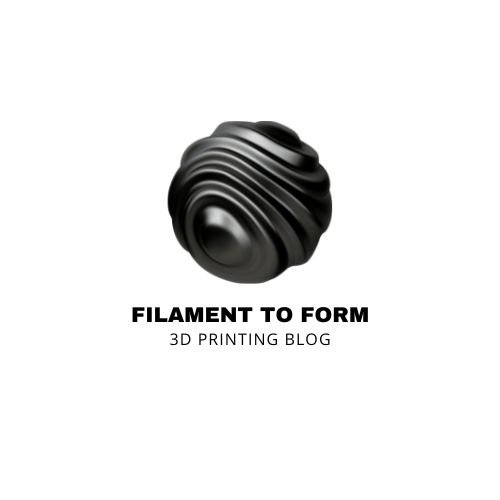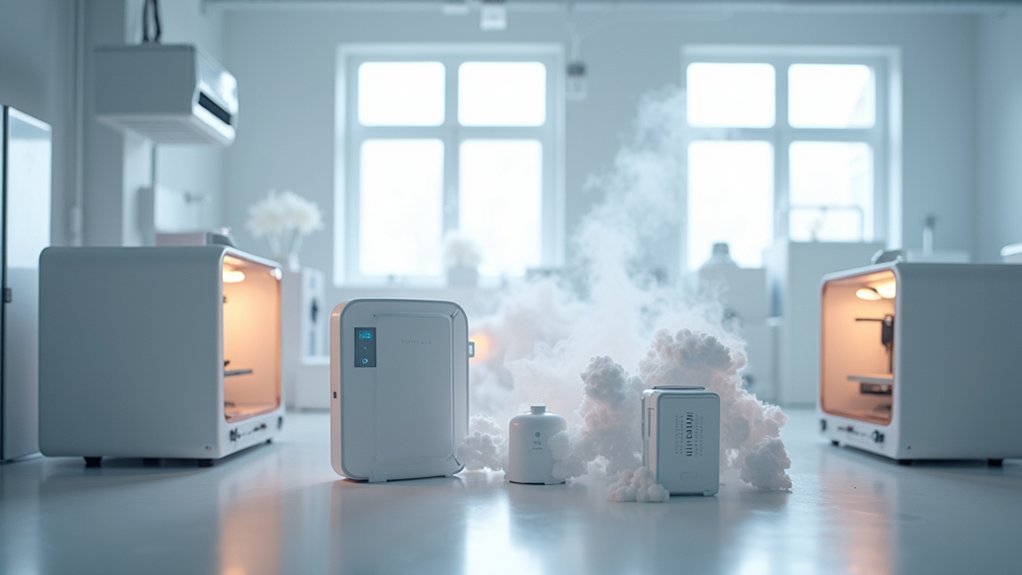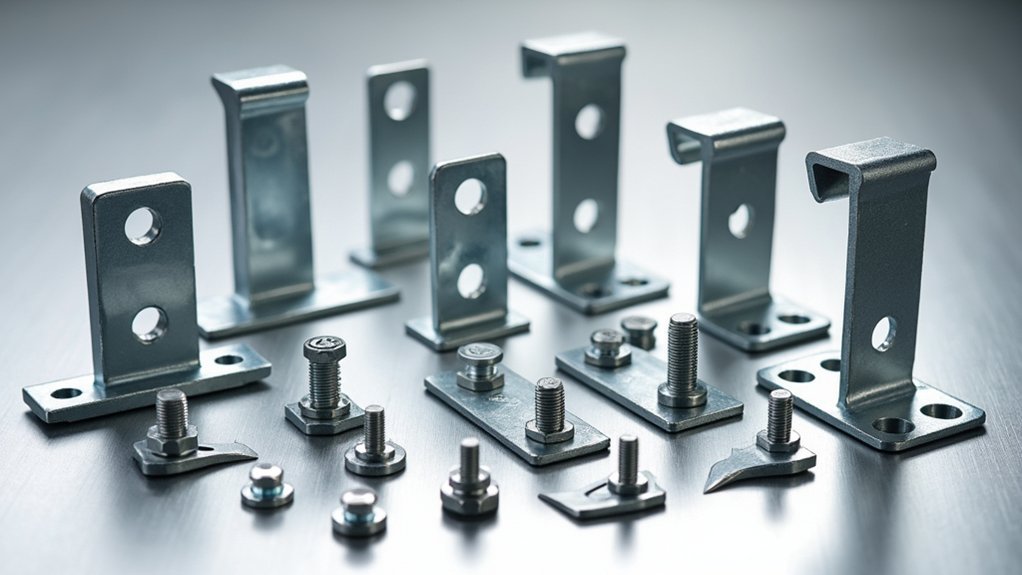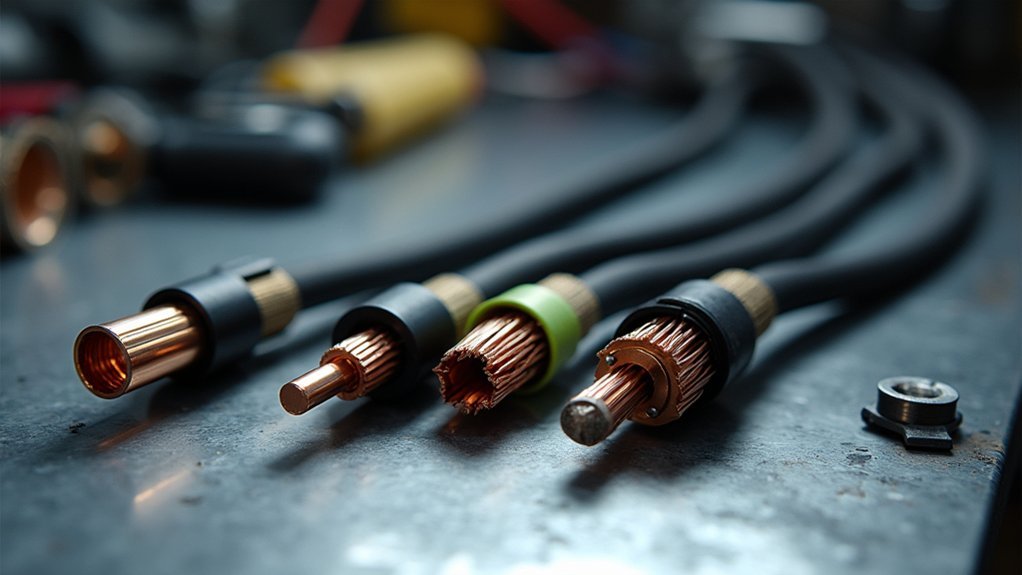You’ve spent hours perfecting your 3D print, but without the right primer, your paint job won’t live up to your model’s potential. The difference between amateur and professional results often comes down to your primer choice, yet most makers overlook this critical step. Whether you’re working with PLA, ABS, or resin prints, the wrong primer can cause paint adhesion issues, uneven coverage, and disappointing finishes that undermine all your hard work.
ANYCUBIC Multifunctional 3D Models Painting Set for 3D Printing Enthusiasts
If you’re new to 3D print painting and need everything in one package, the ANYCUBIC Multifunctional 3D Models Painting Set delivers extensive coverage from prep to finish. You’ll get cutting tools, filling materials, protective coatings, model fixtures, and five acrylic paint colors plus primer and topcoat. The water-based paints offer strong coverage with low toxicity, while the Japanese nylon brush ensures durability. You’ll appreciate the coloring handle’s blue butyl adhesive grip and paint humidor that keeps colors fresh for seven days. Though you might need multiple coats for full coverage, it’s an excellent starter kit for miniature painting beginners.
Best For: Beginners new to 3D print painting who want a comprehensive starter kit with all essential tools and materials in one package.
Pros:
- Comprehensive kit includes everything needed from prep to finish: cutting tools, filling materials, paints, primer, topcoat, and fixtures
- Water-based paints with low toxicity make it safe for indoor use, plus paint humidor keeps colors fresh for up to 7 days
- User-friendly features like Japanese nylon brush for durability and coloring handle with blue butyl adhesive for better grip
Cons:
- Paint may require multiple coats to achieve full coverage, potentially extending project time
- Instructions could be clearer according to user feedback, which may frustrate beginners
- Paint quality may not meet all expectations, prompting users to eventually upgrade to higher-quality miniature paints
BADGER SNR-216 2 oz 6 Tone Paint Pack
The BADGER SNR-216 stands out as the versatile champion for 3D print enthusiasts who need extensive color options in their primer arsenal. This water-based acrylic polyurethane primer delivers professional-grade performance across six essential tones: white, gray, black, red brown, olive green, and neutral. You’ll appreciate its self-leveling properties and excellent adhesion to plastics, metals, woods, and resins. The formula dries to a hard, flat finish that enhances detail while providing exceptional durability. With 174 customer ratings averaging 4.5 stars, this USA-made primer proves its reliability. However, you must protect it from freezing during shipping to maintain effectiveness.
Best For: 3D print enthusiasts and hobbyists who need a versatile primer with multiple color options for various substrates including plastics, metals, woods, and resins.
Pros:
- Six essential primer colors in one pack (white, gray, black, red brown, olive green, neutral) providing excellent value and versatility
- Self-leveling formula with excellent adhesion that dries to a hard, flat finish while enhancing detail
- Water-based acrylic polyurethane formula made in USA with high customer satisfaction (4.5/5 stars from 174 ratings)
Cons:
- Becomes permanently unusable if exposed to freezing temperatures during shipping or storage
- Limited to 2 oz containers which may not be sufficient for large projects
- Requires careful temperature management during delivery, with customer assuming freeze-damage risk
Vallejo White Acrylic Surface Primer 60ml
Scale modelers and miniature enthusiasts will find their perfect companion in Vallejo’s White Acrylic Surface Primer, a versatile 60ml solution that bridges the gap between raw surfaces and flawless paint jobs. You’ll appreciate its exceptional adhesion to resin, PVC, brass, white metal, and wood surfaces. The matte finish dries quickly and works beautifully with airbrushes at 15-20 PSI settings. You can apply it straight from the bottle or dilute it with Vallejo’s airbrush thinner for ideal flow. With a 4.6-star rating from nearly 5,000 customers, this primer consistently delivers smooth application and professional results for your 3D printed models.
Best For: Scale modelers and miniature enthusiasts who need a reliable primer for resin, PVC, brass, white metal, and wood surfaces that works well with both brush and airbrush application.
Pros:
- Excellent adhesion to multiple surface types including 3D printed models with fast-drying matte finish
- Versatile application options – can be used straight from bottle or diluted with airbrush thinner for optimal flow
- High customer satisfaction with 4.6-star rating from nearly 5,000 reviews praising smooth application and professional results
Cons:
- Limited to indoor use only, restricting application locations
- Some customer concerns about packaging quality during shipping
- No warranty coverage specified for the product
Vallejo Grey Acrylic Surface Primer 200ml
Airbrushing enthusiasts will find their perfect match in Vallejo Grey Acrylic Surface Primer, a specially formulated coating designed to deliver professional-grade results on 3D printed models. You’ll appreciate its exceptional adhesion properties and fast-drying matte finish that creates an ideal foundation for subsequent paint layers. Set your compressor to 15-20 PSI for best application, though you can dilute it with Vallejo Airbrush Thinner if needed. The 200ml size provides excellent value for larger projects, while the primer’s extraordinary hardness develops within hours of application. Always wash your 3D prints before priming to remove release agents for maximum adhesion.
Best For: Airbrushing enthusiasts and hobbyists working on 3D printed models, figures, and miniatures who need a professional-grade primer with excellent adhesion and fast-drying properties.
Pros:
- Specially formulated for airbrushing with optimal performance at 15-20 PSI compressor settings
- Fast-drying matte finish that develops extraordinary hardness and resistance within hours
- Large 200ml size provides excellent value for extensive projects and multiple models
Cons:
- Requires proper compressor equipment and airbrushing setup for optimal application
- Models must be pre-washed to remove release agents, adding an extra preparation step
- May need dilution with additional Vallejo products for specific consistency preferences
Badger Air-Brush Co. Stynylrez 3 Piece Assortment (SNR-410)
Professional airbrush artists and serious hobbyists will find exceptional value in Badger Air-Brush Co.’s Stynylrez 3 Piece Assortment (SNR-410), a thorough primer solution that delivers unmatched versatility for 3D print painting projects. You’ll receive 12 ounces of ready-to-use, water-based acrylic polyurethane primer in white, gray, and black. This USA-made formula requires no thinning and works flawlessly with .03mm to .5mm airbrushes. You’ll appreciate its superior adhesion to plastics, metals, woods, and resins, plus its fast-drying properties that accelerate project completion. The self-leveling formula provides excellent coverage while enhancing detail visibility for professional results.
Best For: Professional airbrush artists and serious hobbyists working on 3D prints, miniatures, and multi-material projects who need reliable, ready-to-use primers with superior adhesion and fast-drying properties.
Pros:
- Ready to use straight from the bottle with no thinning required, works with airbrushes from .03mm to .5mm
- Superior adhesion and durability on multiple substrates including plastics, metals, woods, and resins
- Self-leveling formula with fast-drying properties that enhances detail visibility and accelerates project completion
Cons:
- Can be challenging to clean from airbrush equipment, requiring lacquer thinner for effective cleanup
- Product becomes unusable if frozen during shipping or storage in extreme cold conditions
- Not recommended for children under 14 without adult supervision due to safety requirements
Factors to Consider When Choosing Primer Sets for 3D Print Painting
When selecting primer sets for your 3D prints, you’ll need to evaluate several critical factors that directly impact your painting results. Consider how well the primer adheres to your specific filament material, whether it’s compatible with your chosen paint type, and how quickly it dries for your workflow needs. You’ll also want to assess the application methods available and determine if the primer provides adequate coverage depth for your project’s requirements.
Paint Type Compatibility
Understanding paint type compatibility guarantees your primer will work seamlessly with your chosen topcoats and provide perfect adhesion to your 3D printed surfaces. Water-based acrylic primers offer excellent versatility, working effectively with most paint types while delivering superior cleanup convenience. You’ll find these primers particularly compatible with acrylic paints, guaranteeing chemical bonding that prevents peeling or flaking over time.
Consider your intended finish when selecting primers. Matte primers work best under flat topcoats, while glossy primers enhance metallic or high-sheen paints. If you’re planning to airbrush, verify your primer’s formulation supports airbrush application with your compressor’s pressure settings. Self-leveling primers enhance detail preservation, making them ideal for intricate miniatures. Always verify drying times align with your paint system’s requirements for peak adhesion and durability.
Surface Adhesion Quality
Since surface adhesion determines whether your paint job will last or chip off within weeks, selecting a primer with superior bonding capabilities becomes your most critical decision. You’ll need primers that excel across multiple substrates—plastics, metals, woods, and resins—since 3D prints use various materials requiring different adhesion approaches.
High-quality primers create molecular bonds with your model’s surface, providing the foundation for durable paint layers. Look for products with proven adhesion ratings that resist chipping and wear over time. However, even the best primer won’t perform without proper preparation. You must wash your models thoroughly to remove release agents and oils that prevent adhesion. This simple step dramatically improves bonding performance, ensuring your primer grips the surface effectively and maintains long-lasting results.
Drying Time Requirements
Drying time directly impacts your painting workflow and determines how quickly you can complete your projects. Water-based primers often provide the fastest drying properties, allowing for rapid project turnaround that keeps you productive. Airbrush primers typically dry within minutes due to their specialized formulation, while brush-on variants require longer waiting periods between coats.
You’ll want to prioritize fast-drying options if you’re working on multiple layers or tight deadlines. Always check manufacturer specifications for exact drying times, as these vary considerably between brands and formulations. Remember that environmental factors like humidity and temperature affect drying performance, so consider your workspace conditions when selecting primers for ideal results.
Application Method Options
Two primary application methods affect how you’ll prime your 3D prints: airbrushing and brush application. Airbrushing delivers smooth, even coverage that’s particularly effective on intricate models with complex details. You’ll want to set your compressor between 15 to 20 PSI for peak performance and proper surface adherence. Water-based primers are especially convenient for airbrush use since they typically don’t require thinning, allowing immediate application.
Brush application offers more precise control over primer placement but demands extra effort to achieve the same even finish you’d get from airbrushing. Regardless of your chosen method, water-based primers make cleanup straightforward—you’ll only need soap and water rather than harsh solvents, making them particularly user-friendly for hobbyists.
Color Coverage Depth
Understanding color coverage depth becomes essential when selecting primers that’ll effectively conceal your 3D print’s original material and surface imperfections. You’ll find that some primers require multiple coats to achieve full opacity, which directly impacts your project’s time and material costs.
When choosing between water-based and solvent-based formulations, consider how each affects coverage performance. Light-colored primers work exceptionally well when you’re shifting to darker topcoats, while darker primers enhance lighter colors’ vibrancy.
Don’t overlook your primer’s self-leveling properties and detail enhancement capabilities, as these characteristics greatly influence your final color coverage appearance. Select primers that align with your desired finish quality to guarantee professional-looking results on your 3D printed models.
Temperature Storage Needs
While selecting primer sets for your 3D printing projects, you’ll need to account for temperature storage requirements that can make or break your primer’s performance. Water-based primers become unusable when exposed to freezing temperatures, so you must maintain consistent storage above 32°F to preserve their integrity and effectiveness.
Consider your local climate carefully before purchasing. If you live in colder regions, confirm you’ve got indoor storage space that won’t fluctuate dramatically. You’ll also want to avoid shipping during extreme cold, as frozen products won’t perform as intended upon arrival.
Check manufacturer recommendations for ideal temperature ranges. Most suggest indoor storage to prevent temperature swings that’ll compromise your primer’s quality and professional results.
Material Substrate Support
Different 3D printing materials demand specific primer formulations to achieve proper adhesion and professional results. You’ll need to match your primer to your substrate—whether you’re working with PLA, ABS, PETG, or resin prints. Acrylic primers offer exceptional versatility, delivering strong adhesion across multiple materials while providing that essential matte finish for paint application.
Before priming, you must thoroughly wash your models to eliminate release agents and surface contaminants that’ll compromise adhesion. Water-based primers work particularly well for detailed miniatures, offering smoother application and easier cleanup. Consider your painting method when selecting primers—airbrush-specific formulations guarantee even coverage and faster drying times. The right primer creates the foundation for professional-quality paint jobs that won’t chip or peel.
Volume Size Selection
Three key factors determine the ideal primer volume for your 3D printing projects: project scale, application frequency, and storage constraints. Small 60 ml primer sets work perfectly for miniatures and occasional painting sessions, providing multiple applications without overwhelming your workspace. However, if you’re tackling extensive projects or painting multiple models regularly, 200 ml volumes offer superior cost-per-ounce value and eliminate frequent reordering.
Consider your application method when selecting volume sizes. Airbrush users benefit from ready-to-use formulations that don’t require thinning, making larger volumes more practical. Don’t overlook shelf life limitations—primer sets have limited usability once opened. Choose volumes you’ll realistically consume within the recommended timeframe to prevent waste and guarantee peak performance throughout your painting projects.
Frequently Asked Questions
How Long Should Primer Dry Before Applying Paint to 3D Printed Models?
You should wait 2-4 hours for primer to dry completely before painting your 3D printed models. Don’t rush this step – proper drying time guarantees better paint adhesion and prevents peeling or bubbling issues.
Can Primer Sets Be Used on Different 3D Printing Materials Like PLA and ABS?
You can use most primer sets on different materials like PLA and ABS. However, you’ll get better adhesion results if you choose primers specifically formulated for each material type.
What’s the Difference Between Brush-On and Spray Primer for 3D Prints?
Brush-on primer gives you precise control and works well for detailed areas, but you’ll see brush marks. Spray primer creates smooth, even coverage quickly, though you’ll need proper ventilation and masking.
Do I Need to Sand 3D Printed Surfaces Before Applying Primer?
You don’t always need to sand before priming, but light sanding with 220-400 grit improves primer adhesion and smooths layer lines. Skip sanding if you’re using high-fill primers on detailed models.
How Many Primer Coats Are Typically Needed for Professional Painting Results?
You’ll typically need two primer coats for professional results. Apply the first coat thinly, let it dry completely, then add a second coat. This guarantees proper coverage and creates an ideal base for your topcoat.





Leave a Reply